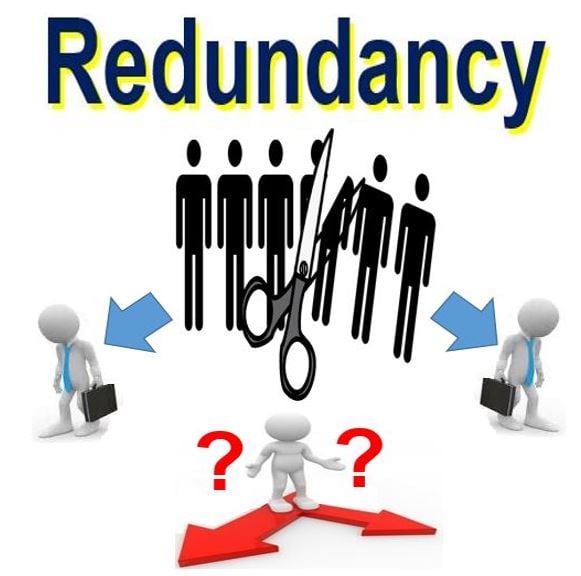Who Pays Redundancy Money? A Thorough Overview for Companies and Employees
Wiki Article
Examining the Interaction In Between Firm Redundancy and Organizational Flexibility for Future Development
In the vibrant landscape of today's organization world, the intricate partnership between business redundancy and organizational flexibility becomes a crucial variable for continual development and success. Companies often deal with the obstacle of striking a delicate balance in between preserving a level of redundancy to minimize threats and fostering flexibility to react promptly to the ever-evolving market demands. This fragile interplay holds the key to not just surviving in stormy times but additionally prospering in the face of unpredictability. As we check out the diverse dimensions of this interaction, intriguing insights into how organizations navigate these complexities to pave the method for future development wait for.Significance of Firm Redundancy
Firm redundancy is an essential component that boosts organizational resilience and mitigates operational risks. By including redundancy actions within the organizational structure, companies can better hold up against unpredicted disruptions and variations in the company setting. Redundancy works as a tactical buffer, enabling business to adapt and react properly to unanticipated challenges without compromising essential operations.One key element of the relevance of firm redundancy is its role in guaranteeing connection during times of crisis. When confronted with sudden changes or emergencies, repetitive systems, resources, or employees can step in to preserve vital functions and stop widespread disruptions. This continuity not only safeguards the business's online reputation and client depend on yet additionally lessens economic losses and operational downtime.

Approaches for Organizational Adaptability

Producing adaptable organizational structures that enable for quick modifications to market characteristics and client requirements is essential for staying competitive in a rapidly evolving atmosphere. By proactively recognizing possible interruptions and opportunities, organizations can proactively adjust and flourish in an ever-changing service landscape.
Harmonizing Redundancy and Versatility
Attaining a harmonious balance in between operational redundancy and organizational adaptability is extremely important in browsing the complexities of a vibrant business setting. Redundancy within a firm provides a safety internet, ensuring continuity and security in procedures. However, an extra of redundancy can cause inefficiencies and prevent versatility to transforming market conditions. On the various other hand, organizational versatility enables companies to respond quickly to exterior disturbances and confiscate new possibilities. Striking the right equilibrium in between redundancy and flexibility is a delicate process that requires a deep understanding of the organization's goals, sector dynamics, and risk resistance.To achieve this equilibrium, companies require to anonymous perform normal evaluations of their procedures to identify areas where redundancy is needed for threat reduction and where versatility can drive innovation and development. Carrying out flexible frameworks, cultivating a culture of constant knowing and renovation, and encouraging open communication throughout all levels of the company are essential methods to balance redundancy and versatility successfully. By aligning these two crucial components, companies can place themselves for lasting development and success in an ever-changing organization landscape.
Study on Adaptation Success
In analyzing instances of effective business adaptation, it becomes apparent that the interplay in between operational redundancy and adaptability is a defining consider forming resilient companies. One engaging instance research study is that of Netflix. Initially a DVD rental solution, Netflix showed exceptional versatility by transitioning into a streaming platform when digitalization disrupted the industry. By purposefully investing in innovation and content creation, Netflix not only endured however thrived in a rapidly evolving market. Another standout instance is Amazon. Beginning as an on-line bookstore, Amazon continuously adjusted its business model, increasing into diverse industries such as cloud computer and fabricated knowledge. This adaptability permitted Amazon to remain ahead of competitors and meet transforming customer needs. Last but not least, Adobe provides a significant image of effective adaptation. The firm moved from selling software licenses to a subscription-based design, ensuring repeating profits site here streams and enhanced client engagement. These study highlight the value of functional redundancy paired with organizational adaptability in fostering long-lasting growth and competition.Building Strength for Future Growth
Building durability for future growth calls for a critical placement of functional procedures with market dynamics and arising trends. Business have to adapt to transforming atmospheres by cultivating a society of flexibility, innovation, and continual improvement. Strength includes not only recovering from troubles but also proactively preparing for future difficulties. One key aspect of structure durability is buying durable risk monitoring methods to alleviate prospective disruptions. This includes scenario preparation, expanding supply chains, and developing contingency plans for numerous backups (who pays redundancy money).Additionally, cultivating strong relationships with stakeholders, such as clients, workers, providers, and the neighborhood, is vital for maintaining and weathering unpredictabilities count on and assistance throughout stormy times. Effective interaction and transparency play a vital duty in building resilience, as they assist align assumptions and promote partnership in navigating unpredictabilities.
In addition, organizations require to focus on knowing and development efforts to upskill employees and equip them with the required tools to adapt to changing scenarios. By buying their labor force, companies can boost their adaptability and agility, ultimately reinforcing their strength for sustainable future growth.
Conclusion

In the dynamic landscape of today's company world, the detailed partnership in between business redundancy and business adaptability emerges as a vital element for continual growth and success. Business frequently face the difficulty of striking a delicate balance between keeping a degree of redundancy to mitigate threats and cultivating versatility to respond promptly to the ever-evolving market demands.To accomplish this equilibrium, firms require to conduct normal assessments of their operations to determine areas where redundancy is essential for risk reduction and where versatility can drive technology and growth.In final thought, the interaction between business redundancy and organizational flexibility is essential for future development. Building strength through a mix of discover this redundancy and adaptability will certainly ensure that business are prepared for the challenges of the future.
Report this wiki page